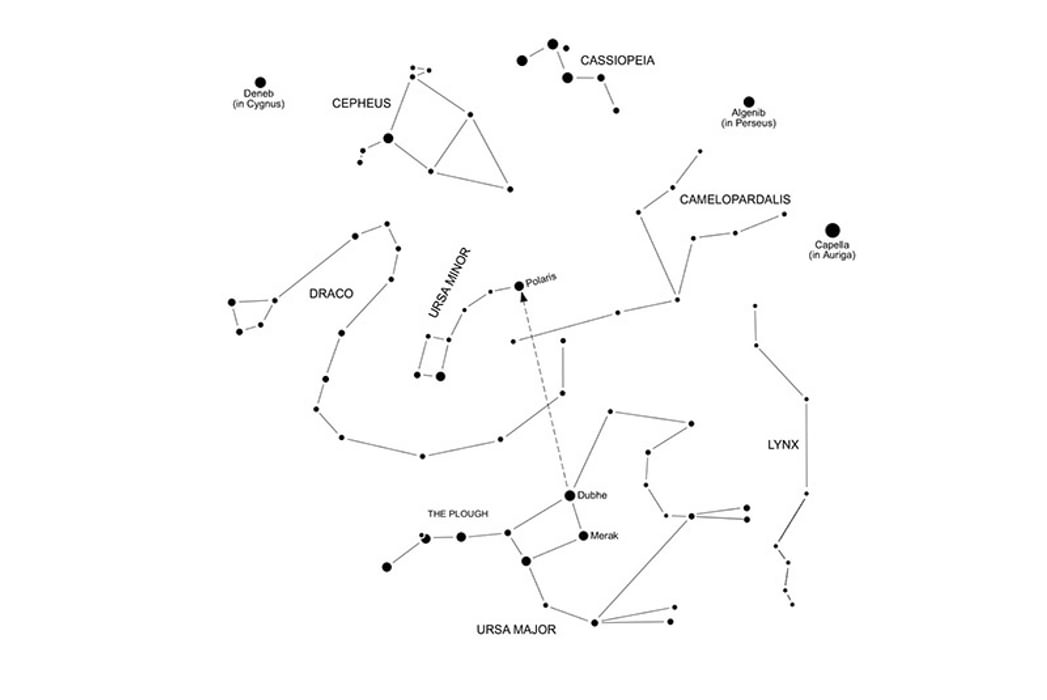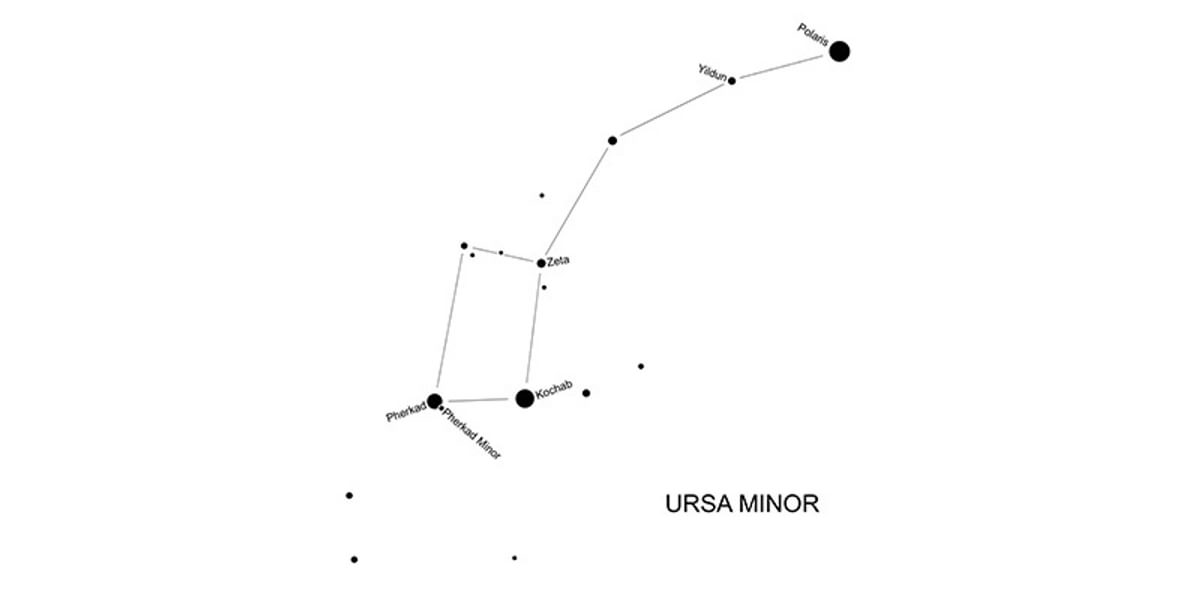Skywatch Autumn: Ursa Minor
In the latest instalment of his regular column for Cicerone Extra, Brian Jones focuses his attention on Ursa Minor, the Little Bear, one of the constellations visible from the UK at all times of the year – on a clear night! If you're out camping, bivvying or staying in a bothy enjoying a 'dark sky', remember to look out for Ursa Minor.
This chart shows the stars and constellations that are described as being circumpolar as seen from mid-northern latitudes, including Great Britain, and features the groups that surround Ursa Minor (the Little Bear) and its prominent leading star Polaris. A circumpolar star or constellation is one that never sets as seen from a given location, but always stays above the observer’s horizon, and can be viewed all year round. Which constellations are circumpolar depends on where you are on the planet. For example, from mid-northern latitudes, the stars shown on this chart are circumpolar and are always on view, although the further south you travel, the fewer circumpolar stars there will be.
As well as the familiar constellations Ursa Major (the Great Bear), Ursa Minor (the Little Bear) and Cassiopeia (Cassiopeia), less well known groups such as Draco (the Dragon), Cepheus (Cepheus) and Camelopardalis (the Giraffe) grace this area of sky. All the constellations shown here will be the subject of future blogs, although our attention this time around is directed towards Ursa Minor.

Ursa Minor is one of the oldest star patterns, appearing in the catalogue of constellations compiled as long ago as the second century by the Greek astronomer Ptolemy. Although by no means the most prominent constellation in the sky, the Little Bear is a familiar sight to backyard astronomers at mid-northern latitudes, and stands out reasonably well due to the fact that the area around it is devoid of bright stars.
Ursa Minor is easily located by using the two end stars in the ‘bowl’ of the Plough as pointers. The Plough is probably the best-known pattern of stars in the sky. Depicting the hindquarters and tail of the Great Bear, the seven main stars forming the Plough are arranged rather like a gigantic heavenly spoon. During late-summer and early-autumn evenings, the Plough can be seen high over the north-western horizon. To find your way to Ursa Minor, first of all locate Merak and Dubhe, the two end stars in the ‘bowl’ of the Plough. Extending an imaginary line from Merak through Dubhe will eventually lead you to Polaris, from where the rest of Ursa Minor stretches away.
Also known as the Pole Star, Polaris is the brightest star in Ursa Minor, the constellation as a whole bearing a strong resemblance to the Plough.
Polaris is almost exactly lined up with the Earth’s axis of rotation and marks the position of the north celestial pole. This means that if you extended the axis around which the Earth rotates up into the heavens it would intersect the sky at a point very close to the star Polaris. A consequence of this is that Polaris always lies due north as seen from the surface of our planet, making Polaris an excellent guide star for navigators. Another is that Polaris remains stationary in the sky as the Earth turns on its axis, with all the other stars appearing to go round it every 24 hours. This situation forms the basis of an Arabic legend which identifies Polaris as a notorious villain who was cast into the sky upon his death. His coffin is represented by the Pole Star and was placed at the northernmost part of the sky, all the other stars keeping their distance as they travel around the heavens.
Even a cursory glance at the Little Bear and the Great Bear will reveal that they both possess long tails, unlike their earthly counterparts. According to legend, Ursa Major represents the maiden Callisto who was so beautiful that Jupiter became infatuated with her. The Roman goddess Juno, the wife of Jupiter, did not think much of this state of affairs, and in a fit of jealousy turned Callisto into a bear, thereby removing her from Jupiter’s advances. Years later, Callisto’s son Arcas almost killed the bear while out hunting although Jupiter managed to rescue the situation by turning Arcas into a bear. Then, in order to render both Callisto and Arcas safe from Juno’s clutches, he grabbed both animals by their tails and swung them high up into the sky where we see them today, the tails of both animals becoming stretched in the process!

Polaris shines at magnitude 2.02 from a distance of 430 light years which means that the light we are seeing from Polaris actually set off towards us around the time of the Spanish Armada, during the reign of Queen Elizabeth I! Although Polaris does not appear to be a particularly bright star, its true luminosity is around 2,500 times that of our Sun, Polaris only appearing faint due to the fact that it lies at such a great distance from us.
Kochab and Pherkad are known collectively as the Guardians of the Pole in that they appear to circle around Polaris as the Earth turns on its axis. Kochab is an orange giant star, its magnitude 2.07 glow reaching us from a distance of around 130 light years, making is one of the closest stars in Ursa Minor. When viewed through binoculars the orange tint of Kochab contrasts quite well with the white of Polaris.
The magnitude 3.00 white giant Pherkad lies at a distance of around 490 light years. This star is sometimes known as Pherkad Major to distinguish it from nearby Pherkad Minor, a magnitude 5.02 orange giant star shining at magnitude 5.02 from a distance of 398 light years. Pherkad and Pherkad Minor can just about be separated with the naked eye under really clear, dark skies, although you’ll probably need a pair of binoculars to resolve the pair easily. The difficulty in splitting this pair of stars without any form of optical aid was alluded to by the English astronomer Joseph Henry Elgie when he wrote that:
‘The very small star close to (Pherkad) is visible to me but seldom. I can just see it at this moment – a shivering moment, for the piercingly cold wind hums about me the while. The Form of the Lesser Bear (Ursa Minor) always reminds me of the Great Bear turned inside out.’
Deriving its name from the Turkish word ‘yildiz’ meaning ‘star’, Yildun shines at magnitude 4.35 from a distance of 172 light years, putting it at less than half the distance of Zeta Ursae Minoris, the magnitude 4.29 glow of which reaches us from a distance of around 370 light years.
To read more articles like this get our newsletter
Sign up for 20% off your next purchase and to be the first to hear about exclusive competitions, special offers, and news from Cicerone.











